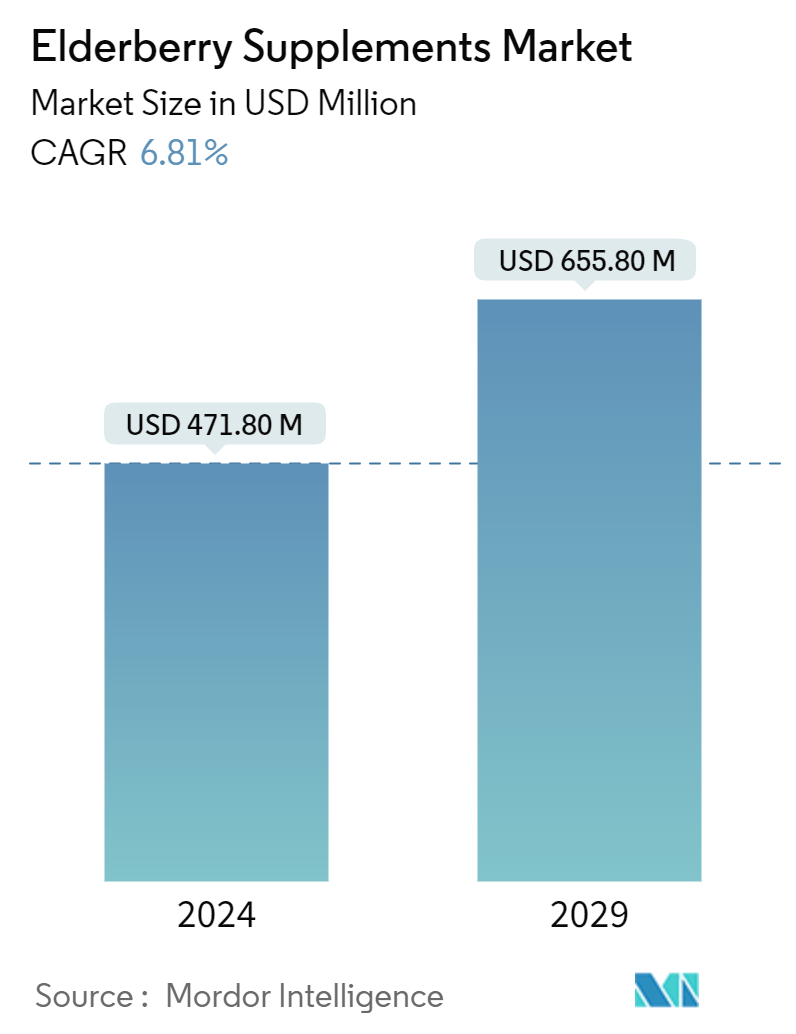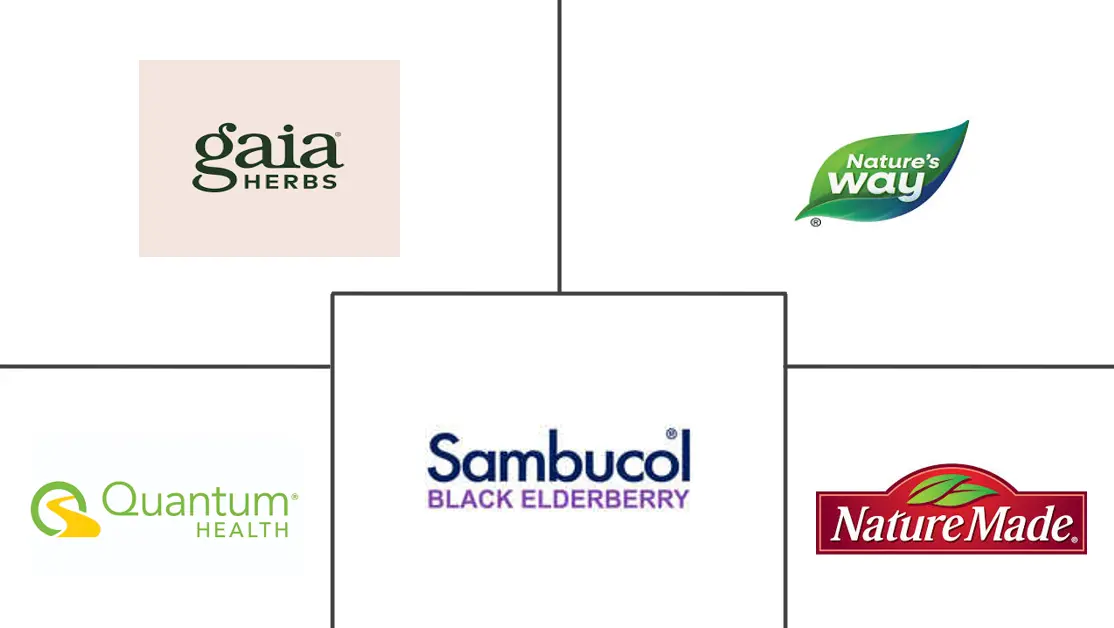Market Size of Elderberry Supplements Industry

| Study Period | 2019 - 2029 |
| Market Size (2024) | USD 471.80 Million |
| Market Size (2029) | USD 655.80 Million |
| CAGR (2024 - 2029) | 6.81 % |
| Fastest Growing Market | Asia Pacific |
| Largest Market | North America |
Major Players
*Disclaimer: Major Players sorted in no particular order |
Elderberry Supplements Market Analysis
The Elderberry Supplements Market size is estimated at USD 471.80 million in 2024, and is expected to reach USD 655.80 million by 2029, growing at a CAGR of 6.81% during the forecast period (2024-2029).
The demand for elderberry supplements is surging globally, driven by their recognized health benefits. Elderberries, known for their high antioxidant content, have a history of being used for their immune-boosting potential. They are particularly valued for their anthocyanins, compounds with reputed anti-inflammatory and antiviral properties, making elderberry a staple in traditional medicine. With a growing trend of health-conscious consumers seeking natural ways to bolster their immunity, elderberry supplements have witnessed a surge in popularity. This rise is further fueled by the widespread belief that elderberries can fortify the immune system and potentially alleviate symptoms of viral infections like the common cold or flu.
According to the Government Statistics of India, in 2022, more than 55% of respondents reported having fallen sick once or twice in a year. Thus, the growing concern and awareness regarding immune health among consumers have contributed to an increased demand for elderberry supplements. Immune health has become a significant focus for many individuals. Moreover, elderberry is increasingly being incorporated into functional foods and beverages, such as elderberry-infused teas, juices, and wellness shots, further driving demand. Furthermore, the availability of elderberry supplements in diverse forms—be it capsules, gummies, syrups, or powders—ensures they seamlessly integrate into daily routines, catering to a wide range of consumer preferences and lifestyles.
Elderberry Supplements Industry Segmentation
Elderberry (Sambucus nigra) is the dark purple berry from the European elder tree. It is a popular ingredient in supplements, and it is commonly used for the common cold, flu, high cholesterol, and many other conditions. The global elderberry supplements market is segmented by form, end user, distribution channel, and geography. By form, the market is segmented into capsules, tablets, syrups, gummies and chews, and other forms. By end user, the market is segmented into kids/children and adults. By distribution channel, the market is segmented into supermarkets/hypermarkets, health and wellness stores, online retail stores, and other distribution channels. The study also covers a global analysis of the major regions, namely, North America, Europe, Asia-Pacific, South America, and Middle East and Africa. For each segment, the market sizes and forecasts are provided on the basis of value (in USD).
Elderberry Supplements Market Size Summary
The elderberry supplements market is experiencing significant growth, driven by increasing consumer awareness of their health benefits, particularly in immune support. Elderberries are rich in antioxidants and are known for their antiviral and anti-inflammatory properties, making them a popular choice for those seeking natural health solutions. The trend towards health consciousness and the desire for natural immunity boosters have led to a surge in demand for elderberry supplements globally. This demand is further amplified by the incorporation of elderberry into various functional foods and beverages, such as teas, juices, and wellness shots, which cater to diverse consumer preferences. The COVID-19 pandemic has also played a crucial role in boosting the popularity of these supplements, as parents increasingly seek natural ways to enhance their children's immune health.
In North America, there is a notable shift towards natural and plant-based products, with elderberry supplements gaining traction as a preferred option for immune support. The market is moderately competitive, with key players like Sambucol USA, Gaia Herbs Farm, and Nature's Way Brands actively engaging in product innovation and strategic partnerships to expand their market presence. The rising incidence of cold and flu cases further fuels the demand for elderberry supplements, as consumers turn to these products to alleviate symptoms and strengthen their immune systems. The market's growth is supported by the availability of elderberry supplements in various forms, such as gummies, capsules, and syrups, making them easily integrable into daily routines.
Elderberry Supplements Market Size - Table of Contents
-
1. MARKET DYNAMICS
-
1.1 Market Drivers
-
1.1.1 Increasing Awareness of Immune Health
-
1.1.2 Consumer Demand for Preventive Healthcare Options
-
-
1.2 Market Restraints
-
1.2.1 Lack of Product Awareness and Availability in Developing Economies
-
-
1.3 Porter's Five Forces Analysis
-
1.3.1 Threat of New Entrants
-
1.3.2 Bargaining Power of Buyers/Consumers
-
1.3.3 Bargaining Power of Suppliers
-
1.3.4 Threat of Substitute Products
-
1.3.5 Intensity of Competitive Rivalry
-
-
-
2. MARKET SEGMENTATION
-
2.1 By Form
-
2.1.1 Capsules
-
2.1.2 Tablets
-
2.1.3 Syrups
-
2.1.4 Gummies and Chews
-
2.1.5 Other Forms (Powder and Softgels)
-
-
2.2 By End User
-
2.2.1 Kids/Children
-
2.2.2 Adults
-
-
2.3 By Distribution Channel
-
2.3.1 Supermarkets/Hypermarkets
-
2.3.2 Health and Wellness Stores
-
2.3.3 Online Retail Stores
-
2.3.4 Other Distribution Channels
-
-
2.4 By Region
-
2.4.1 North America
-
2.4.2 Europe
-
2.4.3 Asia-Pacific
-
2.4.4 South America
-
2.4.5 Middle East and Africa
-
-
Elderberry Supplements Market Size FAQs
How big is the Elderberry Supplements Market?
The Elderberry Supplements Market size is expected to reach USD 471.80 million in 2024 and grow at a CAGR of 6.81% to reach USD 655.80 million by 2029.
What is the current Elderberry Supplements Market size?
In 2024, the Elderberry Supplements Market size is expected to reach USD 471.80 million.

